So I can’t seem to figure out how to import my document and preserve all the formatting so I posted it as photos. There is an all text version below this
Maxwell Brown
Sally Cloninger Ph.D
Ready Camera One
May 5, 2011
Psychedelic Surrealist:
Jim Henson Before Sesame Street
In the thoroughly documented Puppetry: A World History, Eileen Blementhal states “Evolving from prehistoric and early-historic figures in stone, bone, leather or wood, puppets have thrived across eons and continents…facilitated contact that is otherwise hard to achieve, such as with ancestors and gods, but also have served up slapstick and raunchy entertainment. They have given visible form to the vastness of the cosmos but also have shown the intimate interior of a human psyche.”
The world history of puppets is vast and every country and nationality have their classics, including the United States.
The early days of American television produced several famous puppets including Howdy Doody, Kukla, Fran and Ollie and the infamous Charlie McCarthy, whose own fame and notoriety over-shadowed his creator, Edgar Bergen’s own stardom. Radio and television puppets like these as well as a healthy dose of Kovacsian surrealism greatly influenced one of America’s greatest imaginations: Jim Henson’s.
Henson’s work has been a staple of creative encouragement. He is known for his vast technological ingenuity, and is recognized by children (and grown children) around the world. Henson after a brief illness died on May 16, 1990
yet his work continues to be broadcast in over fifty countries
and to this day his commercial empire continues to be profitable today.
At the mere mention of Henson’s name memories undoubtably appear in your mind. Vivid memories of favorite characters like the cute and psychologically complex Kermit the Frog, Bert or Ernie sharing moments of tender thoughtfulness on “Sesame Street” or of one the four-hundred other Muppets he has help create.
It is doubtful that any American television consumer of the last thirty years would not have at least one fond memory of a Henson creation. His staying power is immense with his name on the myriad of still functioning production companies (Jim Henson Corporation, Jim Henson’s Creature Shop), a commercial dynastic empire
helmed by his sons and daughters and of course he is credited with creating the longest running children’s television program in history, Sesame Street
. While many of his characters are universally recognized, Henson’s earlier commercial and experimental works are sometimes overlooked but are worthy of examination by any student of television history.
In 1954 (seven years before the first truly famous Muppet, “Rowlf”) Henson was already following his dream of working in television. Beginning as a puppeteer on Washington DC’s WTOP/CBS,
his first show, which featured characters Pierre the French Rat and cowboys Longhorn and Shorthorn received some positive reviews but lasted only a few weeks. Henson seemed to have a casual indifference towards puppets and viewed them more as tool to explore the capabilities of this new and exciting medium of television. He says “I wasn’t really interested in puppetry then. It was just a means to an end.”
He went back to college at the University of Maryland where he studied commercial art and met his puppet partner and future wife, Jane Nebel.
In 1955 the couple went back to D.C. and fortuitously were given their ‘big break’t a five minute time slot at 11:25pm between Huntley-Brinkley and The Tonight Show hosted by Steve Allen. Of their target audience Nebel remembers “I think were put on the show to do spots for children. But we were college students amusing ourselves, and we did these wild things with puppets, lip-synching to Stan Freeberg records…and things like that. I guess it had a quality of abandon and nonsense and of being somewhat experimental. We were handed the best imaginable audiences.”
Their program which enjoyed six years of success would be called “Sam and Friends” and certainly appealed to the same audiences that enjoyed experimental and irreverent shows like Ernie Kovacs. Henson became interested in the surreal and experimental aspects of television. His indifference to puppets is demonstrated by the fact that during those years he made little attempt to preserve the Sam and Friends programs and solely made kinescopes of those episodes where he was experimenting with special technical effects such as superimposition, unorthodox uses of lenses, animation and special hands free microphones
.
One technique that Henson is credited with innovating is the use of television monitors viewable for the performers. This innovation allowed Henson to see what the audience sees in real time enabling him to perfect the illusion and develop unique styles, exemplified by characteristically subtle expressions, close ups and special effects. David Owen of The New Yorker writes “Henson was unusual even among television pioneers in that he viewed the new medium as being entirely different from anything that had come before…[They] didn’t work on a stage or behind a traditional puppet set. They treated the television screen itself as their theatre.”
Monitors are widely used in modern television production
in everything from news weather reporters to talk shows, but back then it was considered a unique production technique and evidence of Henson’s experimental contribution to the medium of television.
Early episodes of Sam and Friends were produced without the puppeteer’s voices and consisted of a unique ‘visual-music’-of puppets lip synching and pantomiming to records. According to Finch, as Henson’s confidence grew, he began to use his own voice in sketches that parodied shows like Ed Murrow’s Person to Person.
As his confidence grew so did his popularity and commercial success.
In 1957 the Henson’s filmed their first television commercials of Wilkins Coffee. These popular spots only seven seconds long were comical, irreverent and featured stylized proto-Muppets. These commercials (there were more than three hundred made for Wilkins alone
) are a illustrative example of the archival significance of Henson’s work. He describes the attitudes of advertisers of the day “Till then the agencies believed that the hard sell was the only way to get their message over on television. We took a very different approach. We tried to sell things by making people laugh. Bob and Ray were doing the same thing at about the same time…but we were definitely in the vanguard.”
Humor was considered novel in early television commercials and the Hensons continued producing commercials that made people laugh, selling everything from Faygo soda to On-Cor frozen dinners for nearly ten years.
This time of lucrative success allowed Henson and Co. (for now his cadre included Don Sahlin (the true crafter of the Muppets) and Frank Oz (partner and creative puppeteer) to further their experiments within the medium of television and film. Of this time noteworthy innovations include wearable life-size Muppets (such as the La Choy Dragon), the ‘evolution’ characters like Kermit from an ambiguous lizard creature into a true frog and the first national Muppet star, Rowlf.
The Muppets commercials were so successful and popular that big network began seeking their appearances on ‘The Tonight Show’ and ‘The Today Show’. By 1963 several characters were regulars on those shows yet it was on ABC’s “The Jimmy Dean Show” (JDS) where Rowlf, a character originally created for Purina Dog Chow became famous. Henson and Oz performed Rowlf weekly in seven to eight minute long sketches where Jimmie Dean would be upstaged by Rowlf’s quips and occasionally have sing-a-longs. According to Fitch, Rowlf became “so popular that eventually he was receiving more fan mail than Jimmy Dean himself.”
Henson remarks on those days at the JDS as being very influential to the further development of his comedy and the Muppets since he had to learn to interact with other live performers as well as old hand comedy writers. Henson speaks about those writers fondly “They would work with me in terms of performance and the delivery of punch lines. Buddy Arnold was an old-fashioned sock-’em joke person, and you can learn a lot from those guys. You learn to put the funniest word at the end of the punch line, and you learn to deliver that line clean and sharp. If you stumble on your phrase, you’ve killed your laugh and the audience never knows it…So Jimmy Dean was great from a point of view of learning the craft, and Rowlf was the first solid, fully rounded personality we did.”
While Rowlf was shilling everything from food to toy versions of himself and taking Henson and Co into the heights of stardom and commercial success, Henson was unsatisfied with being type-cast and is quoted as saying, “It didn’t seem to be the sort of thing a grown man works at for a living.”
Financially secure and critically acclaimed Henson was able to branch out into his other passions of surrealism, film making, and psychedelia.
Since the 1950’s Henson had access to a 16-mm camera and had been crafting his paintings into experimental animations purely for his own pleasure. Henson says “In those days, I used to think in terms of having two careers going…One was accepted by the audience and was successful, and that was the Muppets. The other was something I was very interested in and enjoyed very much, but it didn’t have any commercial success-which didn’t bother me because I got so much pleasure from working on those non-commercial projects…I thought of myself as an experimental filmmaker.”
Many experiments featured animation and his family and friends around the house but the first to reach a wide audience was the ambitious short film written, produced, directed and starring Henson, titled “Timepiece (1965).”
“Timepiece” is a visually frantic, humorous and perplexing form of visual music where sounds of heart beats and surreal imagery are juxtaposed and jump-cut to create a trance like rhythmic experience with live actors and a certain seriousness that would foreshadow his later endeavors like Labyrinth and The Dark Crystal. “Timepiece” screened at the Museum of Modern Art, new York in May of 1965, ran for eighteen months and was nominated for and Academy Award.
The 1960’s produced further non-Muppet experiments in televised psychedelic surrealism by Henson including his documentary “Youth ’68” which according to Fitch “was an ambitious attempt to use the documentary form to present an impressionistic image of young America at a moment when a revolution in everything from music to clothes to political attitudes was spreading through a whole generation. Hippies, radicals, and straight-looking college students were given the chance to speak for themselves. So were their elders…these interviews were then interspersed with psychedelic footage and glimpses of young Americans from draftees to rock stars.”
Another short lived non-Muppet television series directed by Henson “The Cube” (1969) is considered an avant-garde drama and ‘a stripped down absurdist exercise in which, for reasons the audience is not made privy to, an unnamed man has been imprisoned in a pristine white symmetrical room…He is sealed in this room-unable to leave-even though dozens of characters can get in and out without difficulty.”
His final venture into psychedelia of the 1960’s was a unique combination of film and space called Cyclia. Never actually completed this project was intended to be a night-club/experience, an environment with multiple screens and projected images. Henson had been contemplating this sixteen projector project for years drawing and conceptualizing a new form of epic visual/visceral experience. Henson notes that in his spare time he shot, developed and edited what would end up being thousands of feet of unseen abstract/experimental film intended to be shown in Cyclia. Sadly his innovative idea never came to physical fruition and only exists in a few reels of film and sketches.
All of this amazing success and creativity existed before November 1969 when WNET New York’s Public television channel along with Joan Cooney and the Children’s Television Workshop collaborated with Henson and Co. to create Sesame Street. In spite of research findings that Sesame Street contributed to unusual achievements in “pre-schoolers including recognizing letters, associating sounds with letters and recognizing and sorting geometric forms”
some critics asked of the clearly derived from commercial nature of Sesame Street “were young viewers being taught, or conditioned?”
Wether Sesame Street was a brainwashing tool of corporate interests or the single most valuable television program for children is an argument for academics to further explore. What it unarguably was was a home for Henson and Co. A place where Henson’s animations and Muppets could interact with humans and could follow his dream of illuminating our imaginations for more than thirty years.
Henson later would of course make highly successful five season run of “The Muppet Show,” featuring hundreds of Hollywood stars like Zero Mostel and Steve Martin, which paved the way for the technologically advanced “The Muppet Movie,” the ‘flawed masterpiece” and first all puppet major motion picture “The Dark Crystal.” The list goes on and on including a rarely seen stint on the first season of Saturday Night Live all the way to a Disney 3D experiece.
Jim Henson’s legacy and art is renowned worldwide and his contributions to the art and science of television/filmmaking should be inspirations to any student of television. Personally I find his greatest contribution to my personal agenda to be his exceptional ability to combine psychedelic surrealism, technical ingenuity and humor in a very natural way and will continue to delight countless fans forever. I have to agree with Michelle Ann Abate as she states in her scholarly article, comparing classic traditions of literary absurdity and ‘nonsense’ with Henson’s Muppets, that “Moments of subversive silliness and allegorical absurdity were what made The Muppet Show so popular…these traits help to explain why the production remains so historically significant three decades later. Jim Henson akin to nonsense artists Edward Lear, Lewis Carroll and Dr. Seuss know the importance of taking silliness seriously.”
Annotated Bibliography:
Books
Finch, Christopher Jim Henson: The Works, The Art, The Magic, The Imagination, Random House c1993
His fascinating life is worthy of study for any student of television history and has thoroughly been documented in Christopher Finch’s colorful “Jim Henson: The Works.” Many perspectives of friends and family and interwoven with technical asides and heartfelt narratives that truly paint a well rounded picture of Henson from birth to his untimely passing. The collection of photos and paintings of Henson’s earlier works were of particular interest to me.
Gourse, Leslie; Brown, Robert Jim Henson, young puppeteer Aladdin Paperbacks, Simon & Schuster NY c2000
This is a children’s book that strangely shines some light upon the darker aspects of Henson’s life such as his debated Christian Science upbringing and it’s possible correlation to his death of Pneumonia. Gourse alleges that due to his religious beliefs concerning Western medicine he did not admit himself to the hospital until it was too late.
Barnouw, Erik Tube of Plenty: the evolution of American television, Oxford University Press c1990
Barnouw briefly mentions Sesame Street and neglects Muppets throughout
Millerson, Gerald Television Production 14e Focal Press
Mentions the use of monitors in television production
Blumenthal, Eileen Puppetry: A world history Harry N. Abrams, Inc c2005
In this large tome is the vast history of puppetry of the world. From prehistory to the computer age Blumenthal gives us hundreds of photos from around the world illustrating the myriad of techniques and tales that have captured the imaginations of countless generations. Definitive and fun worthy of any student or fan of puppetry.
Bacon, Matt No Strings Attached: The Inside Story of Jim Henson’s Creature Shop Macmillan NY c1997
This beautiful insider account of mostly theatrical Creature Shop. Filled with production photos and anecdotes that are primarily of Henson’s movies this is not as useful for the study of TV history but wonderful for those interested in animatronics and tangible ‘virtual reality’
Articles
Emmens, Carol A Jim Henson and the People Behind the Muppet Mania SLJ School Library Journal, September 1984
Abate, Michelle Ann Taking Silliness Seriously: Jim Henson’s The Muppet Show, the Anglo American Tradition of Nonsense, and Cultural Critique The Journal of Popular Culture, Vol. 42, No. 4 c2009
Owen, David Looking Out For Kermit, The New Yorker August 16th, 1993
Video Documentaries
Of Muppets and Men: The Making of The Muppet Show (TV 1981) Directed by Peter Berry
The World of Jim Henson (TV 1994) – Great film with lots of old Sam and Friends plus commercials!

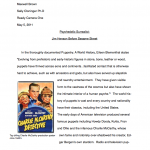
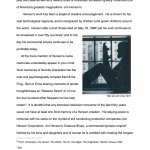



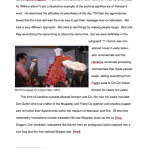

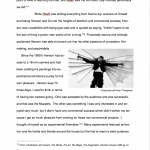
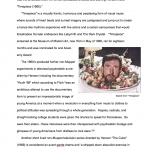

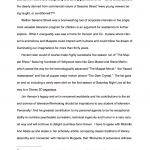

No Comments so far ↓
There are no comments yet...Kick things off by filling out the form below.